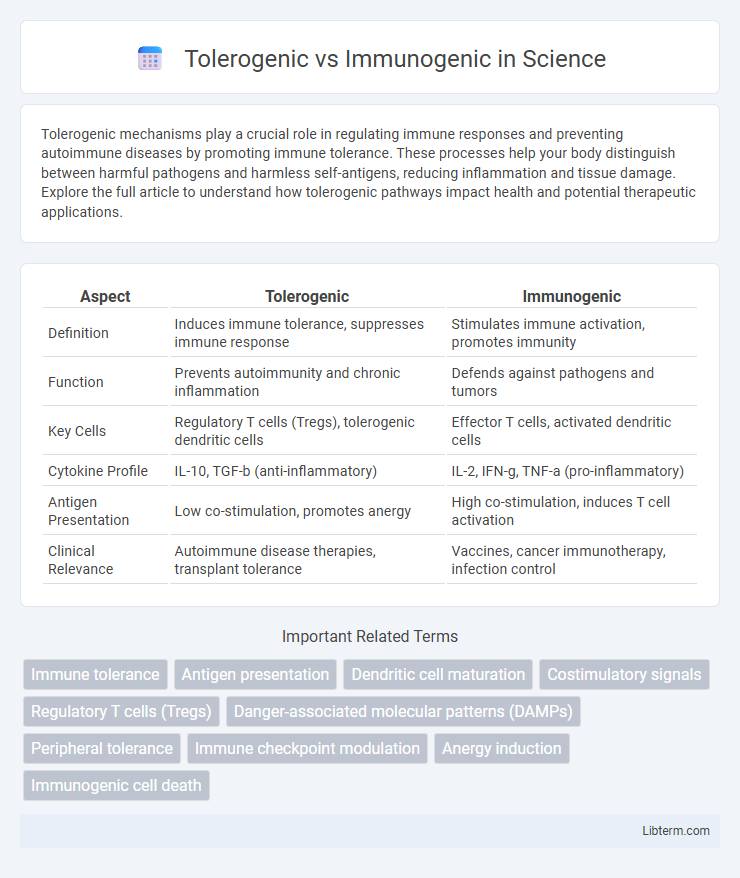Tolerogenic mechanisms play a crucial role in regulating immune responses and preventing autoimmune diseases by promoting immune tolerance. These processes help your body distinguish between harmful pathogens and harmless self-antigens, reducing inflammation and tissue damage. Explore the full article to understand how tolerogenic pathways impact health and potential therapeutic applications.
Table of Comparison
| Aspect | Tolerogenic | Immunogenic |
|---|---|---|
| Definition | Induces immune tolerance, suppresses immune response | Stimulates immune activation, promotes immunity |
| Function | Prevents autoimmunity and chronic inflammation | Defends against pathogens and tumors |
| Key Cells | Regulatory T cells (Tregs), tolerogenic dendritic cells | Effector T cells, activated dendritic cells |
| Cytokine Profile | IL-10, TGF-b (anti-inflammatory) | IL-2, IFN-g, TNF-a (pro-inflammatory) |
| Antigen Presentation | Low co-stimulation, promotes anergy | High co-stimulation, induces T cell activation |
| Clinical Relevance | Autoimmune disease therapies, transplant tolerance | Vaccines, cancer immunotherapy, infection control |
Introduction to Tolerogenic and Immunogenic Responses
Tolerogenic responses promote immune tolerance by preventing overactivation and autoimmunity through mechanisms like regulatory T cell induction and antigen presentation without co-stimulation. Immunogenic responses trigger robust immune activation against pathogens or tumor antigens, involving dendritic cell maturation, cytokine release, and effector T cell stimulation. Understanding the balance between tolerogenic and immunogenic pathways is critical for developing therapies in autoimmune diseases, transplantation, and cancer immunotherapy.
Defining Tolerogenic and Immunogenic Mechanisms
Tolerogenic mechanisms involve the induction of immune tolerance by promoting regulatory T cells and inhibiting pro-inflammatory pathways to prevent overactive immune responses and autoimmunity. Immunogenic mechanisms, in contrast, activate the immune system through antigen presentation, co-stimulatory signals, and cytokine release to elicit robust immune responses against pathogens or abnormal cells. Central to these processes are antigen-presenting cells that dictate whether an antigen triggers immunity or tolerance based on context and molecular signals.
Key Differences Between Tolerogenic and Immunogenic Pathways
Tolerogenic pathways promote immune tolerance by inducing regulatory T cells and suppressing inflammatory responses, while immunogenic pathways stimulate robust immune activation through antigen presentation and effector T cell activation. Key differences include the context of antigen exposure, with tolerogenic pathways favoring self-antigens or harmless antigens to prevent autoimmunity, and immunogenic pathways responding to pathogenic or danger signals to eliminate threats. Molecular signals such as cytokines IL-10 and TGF-b dominate in tolerogenic responses, contrasting with pro-inflammatory cytokines like IL-12 and IFN-g in immunogenic pathways.
Cellular Components Involved in Tolerogenic Responses
Tolerogenic responses predominantly involve regulatory T cells (Tregs), dendritic cells with a tolerogenic phenotype, and myeloid-derived suppressor cells, all of which promote immune tolerance by suppressing effector T cell activity. Specialized dendritic cells expressing low levels of co-stimulatory molecules and high levels of inhibitory molecules such as PD-L1 play a crucial role in inducing T cell anergy or deletion. Additionally, cytokines like IL-10 and TGF-b secreted by these cellular components maintain the immunosuppressive environment necessary for tolerance.
Cellular Components Involved in Immunogenic Responses
Immunogenic responses primarily involve dendritic cells, macrophages, and activated B cells, which function as antigen-presenting cells to initiate T cell activation and promote immune defense. These cellular components express high levels of co-stimulatory molecules such as CD80 and CD86, necessary for stimulating effector T cells and producing pro-inflammatory cytokines. In contrast, tolerogenic dendritic cells and regulatory T cells play a key role in suppressing immunogenic responses by inducing immune tolerance and preventing autoimmunity.
Factors Influencing Tolerogenic vs Immunogenic Outcomes
The balance between tolerogenic and immunogenic outcomes is influenced by antigen type, antigen dose, and the maturation status of antigen-presenting cells (APCs). Cytokine milieu, particularly the presence of IL-10 and TGF-b, promotes tolerogenic responses, whereas pro-inflammatory cytokines like IL-6 and IL-12 favor immunogenicity. The microenvironment and pattern recognition receptor (PRR) engagement also play critical roles in determining whether immune tolerance or activation is established.
Role of Antigen Presentation in Immune Tolerance and Activation
Antigen presentation plays a critical role in determining whether an immune response will be tolerogenic or immunogenic, influencing immune tolerance and activation. Dendritic cells presenting antigens in a non-inflammatory context promote tolerogenic responses by inducing regulatory T cells and anergy, thus preventing autoimmunity. Conversely, antigen presentation along with co-stimulatory signals in an inflammatory environment activates effector T cells, leading to an immunogenic response essential for pathogen clearance.
Clinical Implications: Autoimmunity, Allergies, and Vaccination
Tolerogenic mechanisms induce immune tolerance by promoting regulatory T cells and inhibiting inflammatory responses, crucial for preventing autoimmunity and reducing allergy severity. Immunogenic responses activate effector T cells and produce antibodies essential for effective vaccination and pathogen clearance but can exacerbate autoimmune diseases if dysregulated. Understanding the balance between tolerogenic and immunogenic pathways guides therapeutic strategies for autoimmune disorders, allergy desensitization, and vaccine design to optimize immune outcomes.
Therapeutic Approaches Targeting Tolerogenic and Immunogenic Balance
Therapeutic approaches targeting the balance between tolerogenic and immunogenic responses focus on modulating immune tolerance to treat autoimmune diseases, allergies, and transplant rejection. Strategies include enhancing tolerogenic dendritic cells, regulatory T cell induction, and immune checkpoint modulation to suppress pathological immunity while promoting tolerance. Immunogenic approaches aim to stimulate robust immune activation for cancer immunotherapy and infectious disease vaccines by enhancing antigen presentation and T cell activation.
Future Directions in Immunomodulation Research
Future directions in immunomodulation research emphasize enhancing tolerogenic strategies to treat autoimmune diseases and prevent transplant rejection by promoting immune tolerance without broadly suppressing immunity. Advances in antigen-specific tolerance induction, utilizing nanoparticle delivery systems and gene editing technologies like CRISPR, aim to selectively modulate immune responses and reduce adverse effects. Emerging studies on checkpoint inhibitors and regulatory T cell therapies also hold promise for balancing immunogenicity and tolerance in personalized medicine approaches.
Tolerogenic Infographic

 libterm.com
libterm.com